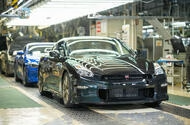Why Did the Nissan GT-R R35 Capture So Many Hearts?
When the Nissan GT-R R35 burst onto the scene in 2007, it didn’t just join the sports car world—it shook it up. Here was a car that promised supercar performance for a fraction of the price, and it delivered. For 18 years, the R35 held its ground, outlasting rivals and building a cult following that stretched from Tokyo to London and everywhere in between.
So, what made it so special? At its core, the R35 was about democratizing speed. It packed a hand-built, twin-turbo 3.8-liter V6 under the hood, producing 473 horsepower in its original form. That meant 0-62 mph in just 3.5 seconds and a top speed that nearly touched 200 mph. Later Nismo versions cranked things up to 592 horsepower, but the real magic was how tuners could push the engine to wild extremes—some builds even flirted with 2,000 horsepower. It wasn’t just a car; it was a blank canvas for enthusiasts.
How Did the GT-R R35 Redefine Performance Benchmarks?
The R35 didn’t just perform well—it embarrassed established names. Nissan famously claimed it beat the Porsche 911 Turbo’s Nürburgring lap time, clocking a 7:38, then later a blistering 7:29. The Nismo version eventually shattered expectations with a 7:08 lap. These weren’t just numbers; they were statements. The GT-R forced the industry to rethink what was possible from a Japanese performance car.
Of course, controversy followed. Porsche questioned Nissan’s methods, suggesting non-standard tires were used. Nissan fired back, insisting their car was in factory spec. The debate only fueled the GT-R’s legend. It became the ultimate “giant killer”—a car that could humble supercars costing twice as much.
What Was It Like to Drive and Own an R35 GT-R?
Ask anyone who’s driven one, and you’ll hear stories about the GT-R’s uncanny grip, its confidence-inspiring all-wheel drive, and the way it made even average drivers feel like heroes. Reviewers raved about its accessible handling and value for money. In 2008, it was crowned Britain’s Best Driver’s Car, beating out more expensive, more exotic competition.
But it wasn’t just about numbers or lap times. The GT-R had character. Each engine was hand-assembled by a small team of master craftsmen, known as Takumi. Owners often talk about the sense of occasion every time they started the car, knowing the heart of their GT-R was built with care and precision.
Why Did Nissan End R35 Production After 18 Years?
All good things must come to an end, and in 2024, the final R35 GT-R rolled off the line. In total, around 48,000 units were built—a remarkable run for a modern sports car. The last version, introduced in 2023, wasn’t even offered in the UK, and Japanese order books filled up almost instantly.
Why stop now? The automotive world is changing fast. Stricter emissions regulations, shifting consumer tastes, and the rise of electrification have made it harder for traditional high-performance cars to survive without major reinvention. Nissan recognized that the R35, as brilliant as it was, belonged to a different era.
What’s Next for the GT-R Legacy?
If you’re a GT-R fan, there’s hope on the horizon. Nissan’s leadership has made it clear: the GT-R badge isn’t going away. Ivan Espinosa, Nissan’s president and CEO, has promised that the GT-R will “evolve and re-emerge in the future.” What that means, exactly, remains a mystery.
The Hyper Force concept, unveiled at the 2023 Tokyo Motor Show, hints at a bold new direction—possibly electric, definitely futuristic. But don’t expect a new GT-R to hit showrooms tomorrow. The R35 itself took six years to go from concept to production, and the next chapter may require even more patience.
How Has the R35 Influenced Car Culture and Tuning?
Beyond the showroom, the R35 became a legend in the tuning world. Its robust engine and drivetrain meant tuners could chase ever-higher horsepower figures, with some builds rivaling the output of full-blown race cars. The GT-R became a fixture at drag strips, car meets, and YouTube channels, inspiring a new generation of enthusiasts.
It also carried the torch from its predecessor, the R34 Skyline GT-R, cementing Nissan’s reputation for building cars that could be endlessly personalized. In a world where many performance cars are locked down by electronics and warranties, the GT-R stood out as a machine that welcomed tinkering.
What’s the Takeaway for Enthusiasts and Collectors?
The end of R35 production marks the close of a remarkable chapter, but its impact will be felt for years to come. If you’re lucky enough to own one, you’re holding a piece of automotive history—a car that challenged the status quo and delivered supercar thrills to the masses.
For everyone else, the GT-R’s story is a reminder that innovation doesn’t always come from the usual suspects. Sometimes, it takes a bold idea, a team of passionate engineers, and a willingness to defy expectations. The R35 GT-R did all that and more.
As we look to the future, it’s clear the GT-R spirit isn’t going anywhere. It’s just getting ready for its next act. And if history is any guide, it’ll be worth the wait.

